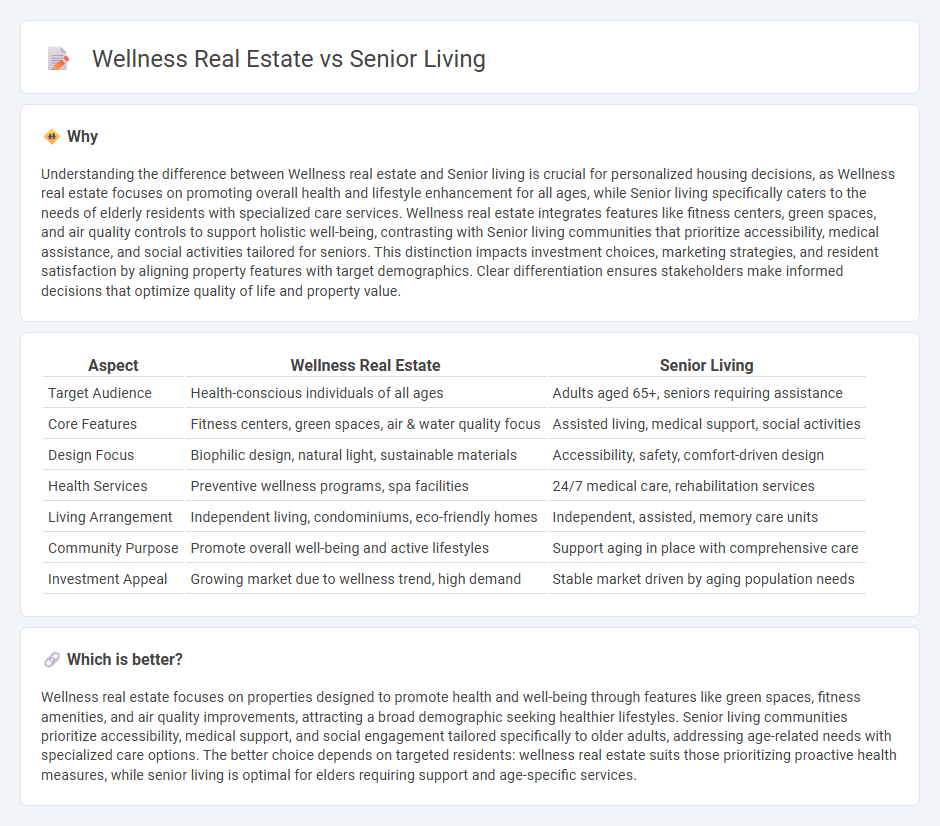
Wellness real estate focuses on properties designed to enhance overall health, integrating features like fitness centers, green spaces, and air quality improvements to promote active lifestyles. Senior living developments prioritize accessibility, safety, and social engagement tailored specifically for older adults, offering services such as healthcare support and community activities. Explore the key differences and benefits of wellness real estate versus senior living to find the ideal housing solution.
Why it is important
Understanding the difference between Wellness real estate and Senior living is crucial for personalized housing decisions, as Wellness real estate focuses on promoting overall health and lifestyle enhancement for all ages, while Senior living specifically caters to the needs of elderly residents with specialized care services. Wellness real estate integrates features like fitness centers, green spaces, and air quality controls to support holistic well-being, contrasting with Senior living communities that prioritize accessibility, medical assistance, and social activities tailored for seniors. This distinction impacts investment choices, marketing strategies, and resident satisfaction by aligning property features with target demographics. Clear differentiation ensures stakeholders make informed decisions that optimize quality of life and property value.
Comparison Table
| Aspect | Wellness Real Estate | Senior Living |
|---|---|---|
| Target Audience | Health-conscious individuals of all ages | Adults aged 65+, seniors requiring assistance |
| Core Features | Fitness centers, green spaces, air & water quality focus | Assisted living, medical support, social activities |
| Design Focus | Biophilic design, natural light, sustainable materials | Accessibility, safety, comfort-driven design |
| Health Services | Preventive wellness programs, spa facilities | 24/7 medical care, rehabilitation services |
| Living Arrangement | Independent living, condominiums, eco-friendly homes | Independent, assisted, memory care units |
| Community Purpose | Promote overall well-being and active lifestyles | Support aging in place with comprehensive care |
| Investment Appeal | Growing market due to wellness trend, high demand | Stable market driven by aging population needs |
Which is better?
Wellness real estate focuses on properties designed to promote health and well-being through features like green spaces, fitness amenities, and air quality improvements, attracting a broad demographic seeking healthier lifestyles. Senior living communities prioritize accessibility, medical support, and social engagement tailored specifically to older adults, addressing age-related needs with specialized care options. The better choice depends on targeted residents: wellness real estate suits those prioritizing proactive health measures, while senior living is optimal for elders requiring support and age-specific services.
Connection
Wellness real estate integrates health-focused amenities such as fitness centers, green spaces, and air quality systems, directly enhancing the quality of life for senior living communities. Senior living developments emphasize accessible design, social engagement, and medical support, aligning with wellness real estate trends that promote holistic well-being. This synergy caters to the growing demand for housing options that support aging populations' physical, mental, and emotional health.
Key Terms
Assisted Living
Assisted Living facilities within senior living communities provide personalized care services tailored to seniors who need help with daily activities while maintaining independence. Wellness real estate emphasizes proactive health management and holistic well-being, integrating fitness, nutrition, and preventive care but typically offers less direct assistance. Discover how Assisted Living uniquely supports aging individuals by blending comfort and professional care for an optimal lifestyle.
Active Adult Communities
Active Adult Communities in senior living offer age-restricted neighborhoods designed for residents typically aged 55 and older, emphasizing social engagement, maintenance-free living, and accessibility features tailored for aging adults. Wellness real estate targets health-conscious buyers by integrating fitness amenities, green spaces, and wellness programs to promote holistic physical and mental well-being in daily life. Explore how these distinct approaches shape lifestyle choices and investments in the evolving real estate market.
Wellness Amenities
Wellness real estate emphasizes integrated health-oriented amenities such as fitness centers, meditation rooms, and spa services designed to promote holistic well-being and active lifestyles. Senior living communities often focus on age-specific support services combined with wellness features tailored to older adults' physical and social needs. Explore how these distinctions influence your health and lifestyle goals by learning more about wellness amenities in each sector.
Source and External Links
Independent Senior Living | Care Options | Houston, TX - Provides high-end senior independent living in Houston, offering benefits like a sense of community, active lifestyle, and decreased home maintenance.
Senior Living Houston | MorningStar at River Oaks - Offers luxury senior living with resort-style amenities, vibrant community life, and personalized care options.
Luxury Senior Living in Houston, TX * The Buckingham - Features a luxury Continuing Care Retirement Community with world-class amenities and personalized care, located in a serene setting near Houston's Memorial neighborhood.
 dowidth.com
dowidth.com